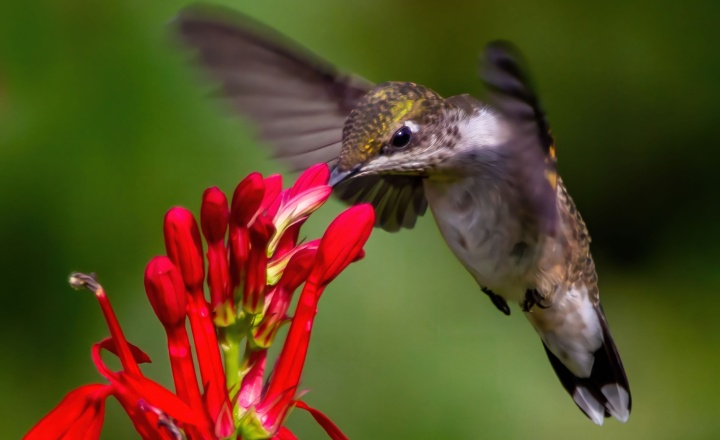

Information Related to "Contemplating Hummingbirds"
 | Audio/Video |
 Joshua Cotten/Unsplash
Joshua Cotten/Unsplash
Living in Colorado, I'm blessed to share space with a great variety of bird species. Over the time I've lived here, bald eagles have nested and reared eaglets at a large lake near my home. I often hear owls on my evening walks. Seeing hawks is a near-daily occurrence. And there are a lot of songbirds that vary with the season.
But of all these, my favorites are the tiny, thumb-sized hummingbirds. One nature photographer dubbed them "flying jewels," and that's what they look like with their iridescent feathers that sparkle and change colors depending on the angle of the light. I've placed hummingbird feeders around my house, so I get to see them often and up close.
Another good description of these tiny birds would be "flying miracles," because that's exactly what they are. Consider first their astounding flight capabilities. While most birds flap their wings up and down to fly, hummingbirds' wings move in a figure-eight motion that enables them to hover in one place, fly backwards or rocket off in any direction in a split second. Their wings beat 50 to 80 times per second, but can reach an astounding 200 in short bursts.
They can fly at 30-35 miles per hour, and one species has been measured diving at 90 feet per second. Relative to size, hummingbirds can fly faster than modern fighter jets, withstanding g-forces that would cause human beings to black out!
These amazing speeds require an equally amazing metabolism. A hummingbird's active heart rate is an astonishing 1,200 beats per minute. To support this metabolism, hummingbirds must feed almost constantly. For a human being to function at this energy level would require eating well over 1,000 hamburgers a day. But no person could do this, because the heart beating this fast would heat the body to 725 °F (385 °C), causing it to literally burst into flames!
Hummingbirds commonly feed on nectar, drinking more than their body weight daily. Their long, needlelike beaks contain a much longer tongue that extends and retracts 15 to 20 times per second when lapping up nectar.
And then there are some species' incredible migrations. One common North American species migrates 4,000 miles from Mexico to Alaska each spring, then reverses the journey in the autumn. Another common North American species migrates over the Gulf of Mexico -- a 500-mile, 18- to 22-hour nonstop trip! More remarkable still, they migrate alone -- even young hummingbirds that have never made the journey before!
How could such amazing creatures have somehow evolved? Evolutionists assure us they did. But how many hundreds or thousands of generations of hummingbirds would have perished trying to fly nonstop over the Gulf of Mexico (in both directions), with a few figuring it out by chance and somehow imprinting that on their young so they could make the same identical journey without ever having done so before?
And how could the hummingbird's beak have evolved to be ideally suited for drinking nectar from trumpet-shaped flowers? How would any hummingbirds have lived long enough to survive and evolve if trumpet-shaped nectar-bearing flowers weren't around and their beaks weren't suitable for getting any other kind of food? And how could trumpet-shaped flowers have evolved and thrived before hummingbirds evolved and were able to pollinate such flowers, enabling them to reproduce?
How could the hummingbird's astonishing flight capabilities have evolved, enabling them to hover in front of a flower and drink from the thousands of flowers they need to drink from daily to sustain their incredible metabolism? The same goes for their unique wing structure and shoulder joints unlike anything seen in other bird species. As the apostle Paul wrote in Romans 1:20 of people everywhere, "Through everything God made, they can clearly see his invisible qualities -- his eternal power and divine nature. So they have no excuse" (New Living Translation).
As shown in the articles in this issue, God's eternal power and divine nature are clearly seen from what He has made. New scientific discoveries constantly confirm this.
Meanwhile, as I enjoy watching the hummingbirds perform their aerial acrobatics around my backyard, I contemplate them and the opening words of Psalms 14 and 53 -- "The fool has said in his heart, 'There is no God.'"
©1995-2022 United Church of God, an International AssociationRelated Information:
Table of Contents that includes "Contemplating Hummingbirds"
Other Articles by Scott Ashley
Origin of article "Contemplating Hummingbirds"
Keywords: evolution hummingbirds creation
God the creator: